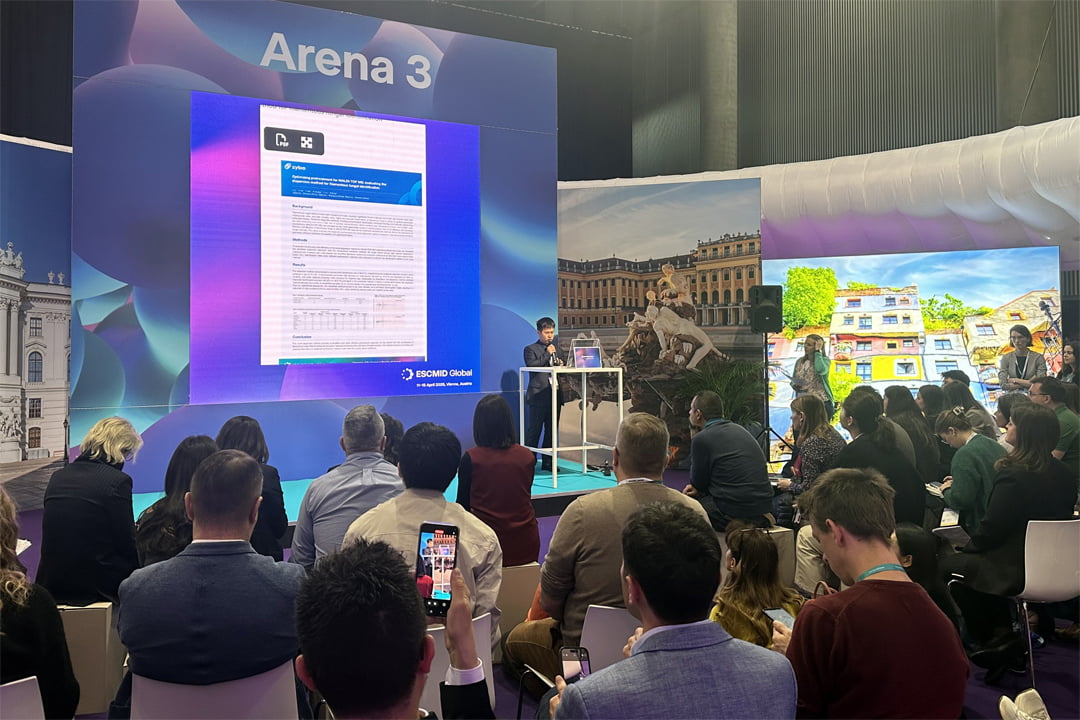Higher Accuracy While ~40% Time Saved: Reliable Dispersion Method of Zybio MALDI-TOF MS Platform Boosting Identification Rates
April 16, 2025 Zybio News
In ESCMID 2025, Zybio had 4 posters successfully accepted. One of them, titled “Optimizing Pretreatment for MALDI-TOF MS: Evaluating the Dispersion Method for Filamentous Fungal Identification”, was delivered as an oral presentation.

Tackling a Global Health Challenge: Invasive Fungal Infections
Invasive fungal infections (IFI) refer to pathological processes where fungi invade human tissues or bloodstream, proliferate, and cause tissue damage, organ dysfunction, and inflammatory responses[1]. In recent years, the increasing complexity of clinical interventions—such as invasive procedures, broad-spectrum antibiotics, immunosuppressants, corticosteroids, and chemotherapy—has led to a rising incidence of IFI[2]. Diagnosis remains challenging, with high mortality rates: 30-day and 90-day overall mortality rates are 30.2% and 42.7%, respectively[3]. Annually, over 105 million people suffer from severe fungal diseases, with related deaths exceeding 1.6 million, comparable to tuberculosis and three times higher than malaria[4]. This makes rapid and accurate fungal identification more essential than ever before.

Figure 1: Common Types of IFI and Their Epidemiological Data[2]
Study Highlights: Innovation in Filamentous fungi pretreatment
Matrix-Assisted Laser Desorption/Ionization Time-of-Flight Mass Spectrometry (MALDI-TOF MS) is recommended by global guidelines for species-level fungal identification[5]. However, filamentous fungi like Aspergillus and Fusarium pose unique challenges due to their robust cell walls.
Zybio’s study evaluates an innovative dispersion method, which significantly improves species-level identification compared to conventional protocols.

98 fungal strains across 8 genera (including Aspergillus, Cladosporium, and Fusarium) were pretreated using both the dispersion method and traditional extraction method. MALDI-TOF MS (EXS3000, Zybio) was employed for analysis comparing efficiency and identification rates.

Dispersion Method--Faster and more accurate
Species-level identification: Dispersion method achieved 83.67% accuracy vs. 76.53% for traditional extraction method.
· Cladosporium: 93.55% vs. 76.47%
· Aspergillus: 81.58% vs. 76.32%
· Fusarium: 100% accuracy for both methods
· Penicillium: 83.33% vs. 66.67%
Fewer undetected samples: 16 (dispersion) vs. 23 (traditional), improving diagnostic reliability
~40% time saved: Dispersion method eliminated centrifugation steps, reducing overall sample processing time while maintaining reproducibility.

How does Zybio MALDI-TOF MS Facilitate Clinical Microbiology
The dispersion method simplifies pretreatment, enhances MALDI-TOF MS efficiency, and enables rapid, precise identification of challenging pathogens. By simplifying workflows and boosting identification rates, the dispersion method represents a significant step forward in clinical micrbiology, supporting early IFI diagnosis and reducing disease burden.
Zybio has been and will always be committed to the concept of "Dedication to Accuracy" and constantly go further in technology of laboratory testing. Meanwhile, we, with customer-centered notion in mind, will improve our services in an all-round and multi-angle manner to provide more comprehensive and efficient solutions for healthcare providers, and in this way, we safeguard patients' lives and health.
· Reference
[1] De Pauw B, Walsh T J, Donnelly J P, et al. Revised Definitions of Invasive Fungal Disease from the European Organization for Research and Treatment of Cancer/Invasive Fungal Infections Cooperative Group and the National Institute of Allergy and Infectious Diseases Mycoses Study Group (EORTC/MSG) Consensus Group[J]. Clinical infectious diseases : an official publication of the Infectious Diseases Society of America, 2008, 46(12): 1813-1821.
[2] Brown G D, Denning D W, Gow N A R, et al. Hidden Killers: Human Fungal Infections[J]. Science Translational Medicine, 2012, 4(165): 165rv13-165rv13.
[3] Van den Nest M, Wagner G, Riesenhuber M, et al. Filamentous Fungal Infections in a Tertiary Care Setting: Epidemiology and Clinical Outcome[J]. Journal of Fungi, 2021, 7(1): 40.
[4] Bongomin F, Gago S, Oladele R O, et al. Global and Multi-National Prevalence of Fungal Diseases—Estimate Precision[J]. Journal of Fungi, 2017, 3(4): 57.
[5] Cornely O A, Sprute R, Bassetti M, et al. Global guideline for the diagnosis and management of candidiasis: an initiative of the ECMM in cooperation with ISHAM and ASM[J]. The Lancet Infectious Diseases, 2025, 0(0).
